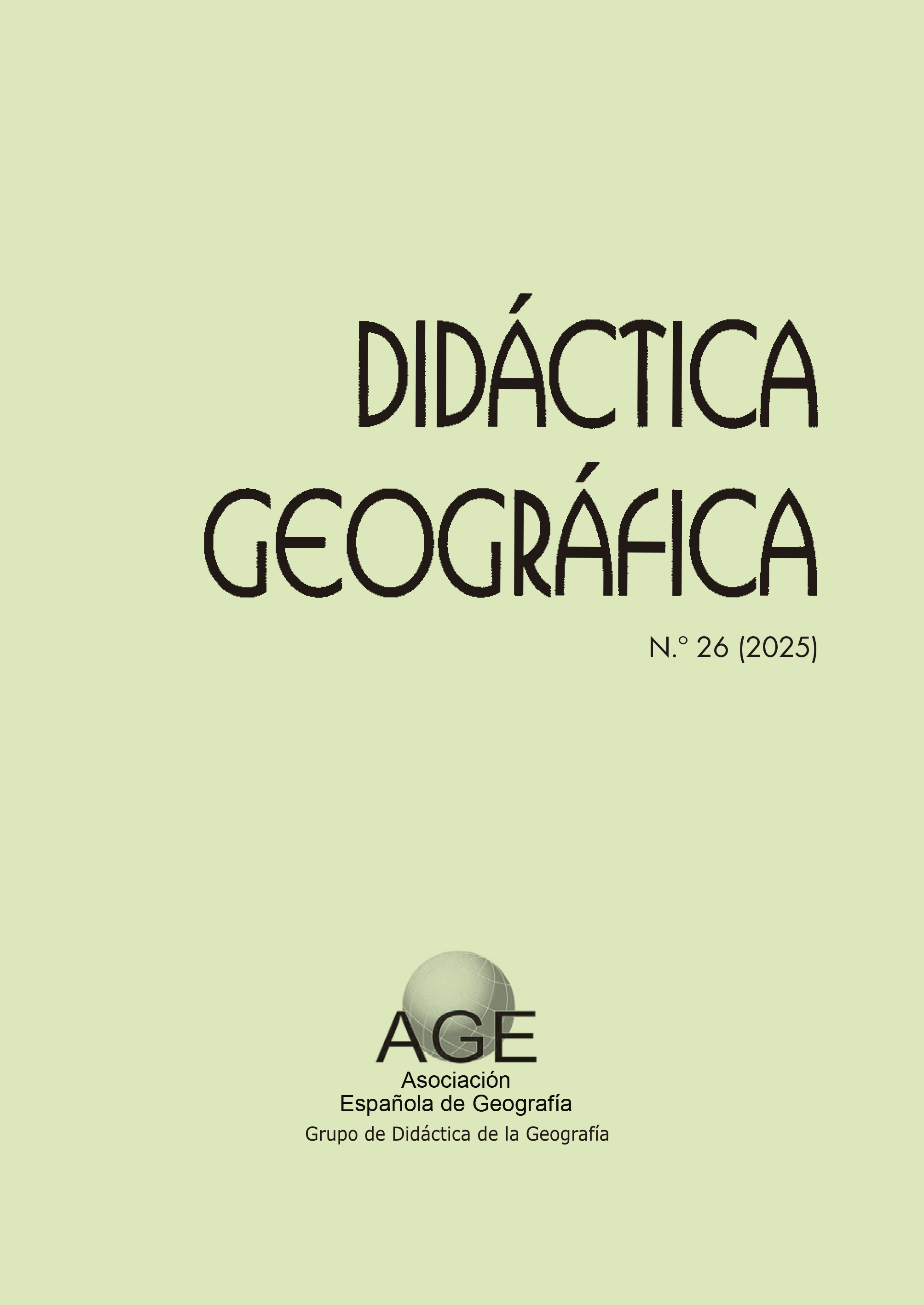The history of geographical thinking through interculturality, gender and climate change: flipped learning in the Degree in Geography
Main Article Content
Abstract
This article presents a teaching innovation project to be implemented in university subjects within the history of geographical thinking, an essentially theoretical subject in the study of different geographical currents and their most significant thinkers, their work and chronology. The course is structured around three thematic blocks to cover the required subjects through collaborative classroom activities on climate change, gender and interculturality, in a context of cultural homogenisation and globalisation. Following a flipped learning methodology, the students work on theoretical contents at home and group/practical activities in the classroom (workshops, shared readings, seminars, group practices) and field outings. Students are evaluated based on the grades assigned for their activities and work, as well as their participation. The project, on the other hand, is evaluated in terms of the academic results achieved, participation and the degree of satisfaction reflected in surveys and tutorials. The implementation of this project over the course of two academic years has yielded excellent results promoting autonomy, self-learning, critical thinking and collaborative work, as well as the acquisition of knowledge and skills through practice in a fundamentally theoretical subject.
Downloads
Article Details

This work is licensed under a Creative Commons Attribution-NonCommercial 4.0 International License.
References
Álvarez Otero, J., & de Lázaro y Torres, M.ª L. (2019). Las infraestructuras de datos espaciales: un reto y una oportunidad en la docencia de la Geografía. Boletín de la Asociación de Geógrafos Españoles, 82, 2787, 1–32. http://dx.doi.org/10.21138/bage.2787
Beato, S. (2024). Geography and Global Change through Interculturality and CLIL. Servicio de Publicaciones. Universidad de Oviedo.
Bergmann, J., & Sams, A. (2012). Flip Your Classroom: Reaching Every Student in Every Class Every Day. International Society for Technology in Education.
Capel, H. (2012). Filosofía y ciencia en la geografía contemporánea. Una introducción a la Geografía. Barcelona: Ediciones del Serbal.
Dafonte-Gómez, A. García-Crespo, O., & Ramahí-García, D. (2018). Flipped learning y competencia digital: diseño tecno pedagógico y percepción del alumnado universitario. Index. comunicación, 8(2), 275-294.
Del Arco Bravo, I., Flores Alarcia, Ò., & Silva, P. (2019). El desarrollo del modelo flipped classroom en la universidad: impacto de su implementación desde la voz del estudiantado. Revista de Investigación Educativa, 37(2), 451-469. DOI: http://dx.doi.org/10.6018/rie.37.2.327831.
de Lázaro, M. L., & Aparicio, C. G. (2014). "Flipped Classroom" y cartografía de conflictos en el aprendizaje de la Geografía. En Nuevas perspectivas conceptuales y metodológicas para la educación geográfica (pp. 301-318). Universidad de Córdoba.
Flores, Ò., del-Arco, I., & Silva, P. (2016). The flipped classroom model at the university: analysis based on professors’ and students’ assessment in the educational field. International Journal of Educational Technology in Higher Education 13. DOI: 10.1186/s41239-016-0022-1.
Gómez-Mendoza, J., Ortega-Cantero, N., & Muñoz-Jiménez, J. (1982). El pensamiento geográfico: estudio interpretativo y antología de textos (De Humboldt a las tendencias radicales). Madrid: Alianza Editorial.
Graves, N. J. (1985). La enseñanza de la geografía, Madrid: Visor.
González-Fernández, N., & Carrillo, G.A. (2016). El Aprendizaje Cooperativo y la Flipped Classroom: una pareja ideal mediada por las TIC. Aularia: Revista Digital de Comunicación, 5(2), 43-48
Lage, M.J., Platt, G.J., & Treglia, M. (2000). Inverting the classroom: A Gateway to creating an inclusive learning environment. Journal of Economic Education, 31(1), 30-43.
Marlowe, C. A. (2012). The effect of the flipped classroom on student achievement and stress (Unpublished master's dissertation). Montana State University, Bozeman, MT.
Nogué, J., & Romero, J. (Eds.) (2006). Las otras geografías. Valencia: Tirant lo Blanch.
Olcina, J., Baños, C. J. (2004). Los fines de la geografía. Investigaciones geográficas, 33, 39-62.
Ortega, J. (2000). Los horizontes de la Geografía. Teoría de la Geografía. Barcelona: Ariel.
Prieto, A., Barbarroja Escudero, J., Corell, A., & Álvarez Álvarez, S. (2021). Eficacia del modelo de aula invertida (flipped classroom) en la enseñanza universitaria: una síntesis de las mejores evidencias. Revista de Educación, 391, 149-177.
Poblete, M.A., & Beato, S. (2020). Atlas de formas de modelado del relieve terrestre como aplicación del método Flipping the profesor. En Mª Aquilina Fueyo Gutiérrez (ed.), XII jornadas de innovación docente 2019 – Libro de Actas (pp. 3030-306). Servicio de Publicaciones de la Universidad de Oviedo.
Souto, X.M. (1998). Didáctica de la geografía. Problemas sociales y conocimiento del medio. Barcelona: Serbal.
Tomlinson, C. A. (1993). Independent Study: A Flexible Tool for Encouraging Academic and Personal Growth. Middle School Journal, 25(1), 55-59.
Tourón, J., Santiago, R., & Díez, A. (2014). The Flipped Classroom: Cómo convertir la escuela en un espacio de aprendizaje. Océano, Digital-Text.
Universidad de Oviedo (2016). Memoria de verificación del Grado en Geografía y Ordenación del Territorio por la Universidad de Oviedo. Disponible en https://www.uniovi.es/estudia/grados/humanidades/geografia

